By Jackie Clay-Atkinson
More and more folks are starting to buy bulk foods to ensure if stores run out of foods — as they did at the onset of this epidemic — their families will still be fed. As we have kept a full pantry for decades, perhaps I can help some of you who are newer to this concept. For just buying bulk foods is not enough; you have to be able to keep them safe and fresh-tasting for long periods of time. After all, it’s pretty disheartening to be counting on a good food supply and then discover it has been infested with insects, eaten by mice, or molded beyond recognition.
The good news is it’s inexpensive and easy to keep all manner of dry foods in excellent condition for years and years. While many tout adding Mylar bags and oxygen absorbers to containers of dry foods (relatively expensive), I’ve kept such foods in perfect condition with quite simple steps.
But first, let’s look at foods you should not buy in bulk unless you can keep them frozen. It’s been my experience that whole grains which have been ground do not store well under common household temperatures. These foods go rancid after only a few months in storage. Foods such as whole wheat flour, whole grain cornmeal, brown rice, and nut flours will not store long unless they’re frozen to protect them from rancidity.
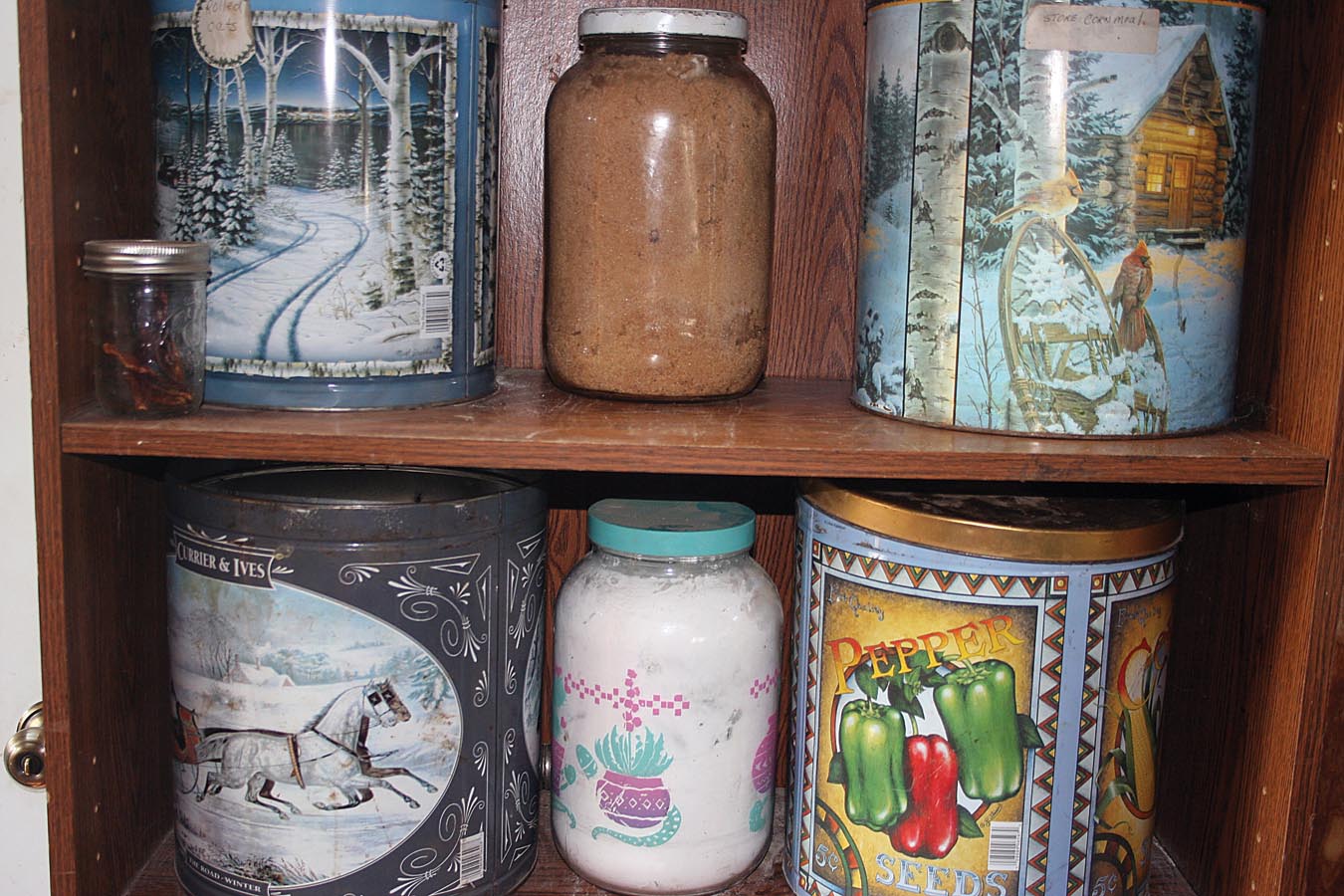
I store lots of my dry food in pretty, recycled popcorn tins.
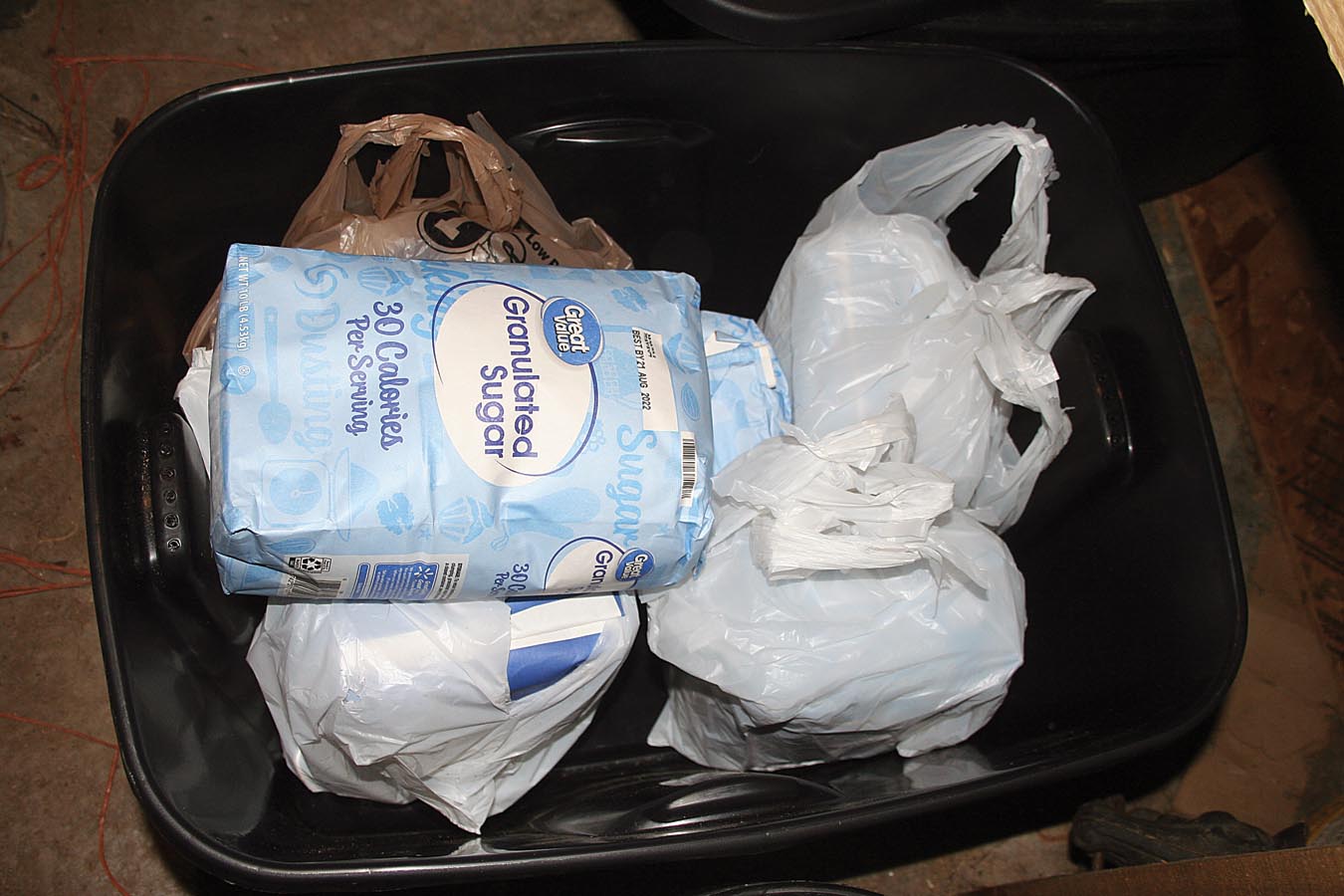
I’ve found sturdy plastic totes work well for 10# bags of sugar and other dry foods.
Likewise, shelled nuts like walnuts, pecans, and almonds won’t keep over long periods unless either canned or frozen. Yeast will keep about a year on a shelf but, of course, you cannot can it so freezing is a good option. I keep about half a pound on my kitchen shelf, half a pound in the refrigerator and a pound in the freezer to cover all bases. Refrigerated, yeast will keep for more than a year with ease, often two years or even more.
You may ask what you can do, then, if you prefer to use whole grain flours as our family does. The answer is simple; store whole grains like wheat, rye, and corn, then grind them before using and store them for shorter times.
So how do I store my dry foods? The answer is easy; I store them in any insect, moisture, and relatively air-tight container. These range from new garbage cans of various sizes, five-gallon buckets with gasketed lids, glass and plastic gallon jars, to (my favorite for kitchen use) recycled metal popcorn tins. The big containers like garbage cans and five-gallon buckets are stored out of sight in the basement where the smaller containers like my pretty popcorn tins and gallon jars sit on shelves and on the counter where they are handy. After all, these smaller containers hold foods I use daily and I want them handy.
In my popcorn tins and gallon jars I have these foods: unbleached flour, store-bought cornmeal (which is not whole grain and will store indefinitely), rolled oats, dry milk, chocolate chips, beans, soup peas, sugar, long grain white rice, spaghetti, several varieties of dry pasta shells and noodles, confectioners’ sugar, brown sugar, and complete pancake mix.
On my counter I have half-gallon jars full of freshly ground cornmeal and whole wheat flour as well as a jar of brown rice to use soon.
So where do I get my containers? Most usually come from the dump, especially the popcorn tins, which I pick up (with permission) right after Christmas when the yummy contents have been eaten and improvident people just toss. I also tell my friends and relatives to save me any tins they don’t want. I have all I need and some to pass on to my friends who are beginning to stock up.
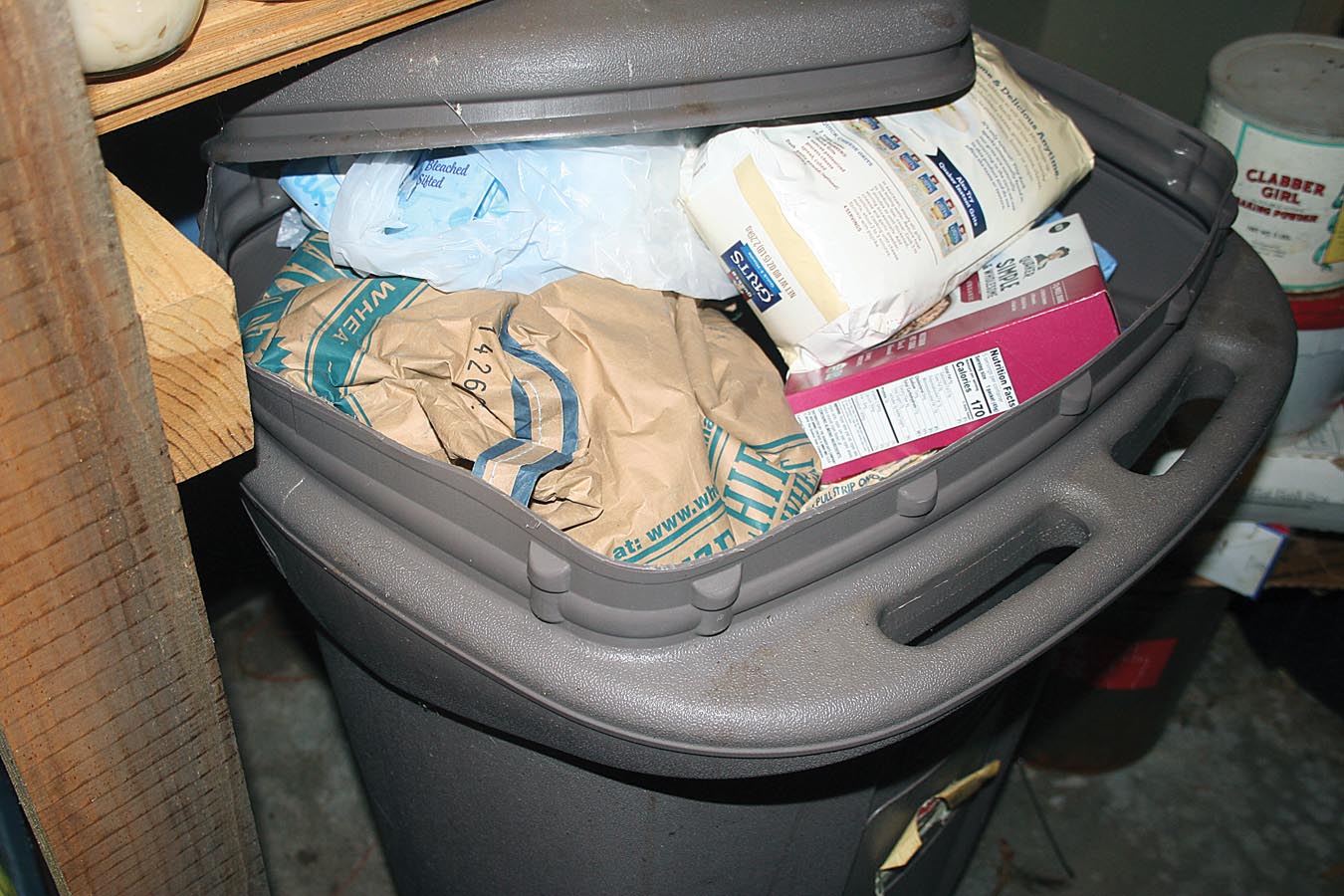
New garbage cans can be stuffed with various bags of dry foods or whole grains like wheat or corn.
The five-gallon buckets come from the bakery section of a near-by large grocery store. They come filled with icing and when empty, they wash them out and sell them, complete with lids, for $1 each. The bonus is they also have gasketed lids.
If you can’t find such buckets, most farm and ranch and even big box stores carry five-gallon buckets and lids. I’ve even seen those wonderful (but kind of pricey) twist-to-open lids in our local farm store. One tip, if you store your foods in these five-gallon buckets, also buy a lid-opener. This handy-dandy and cheap tool will save you countless broken fingernails and cuss words when you try to open pails! Mine hangs on a nail by my stash of full buckets.
You can often find gallon jars at the deli section of a grocery (you usually have to ask), as such things as mayonnaise, relish, and pickles come in them and they just toss the empties in the dumpster out back. You can also buy gallon and smaller glass jars at your local Walmart or other big-box store for relatively low prices.
As for the garbage cans, I’m sure you can find them at any hardware or big-box store. I use mostly large cans as I stuff them with such foods as flour, sugar, white rice, whole grains, etc.
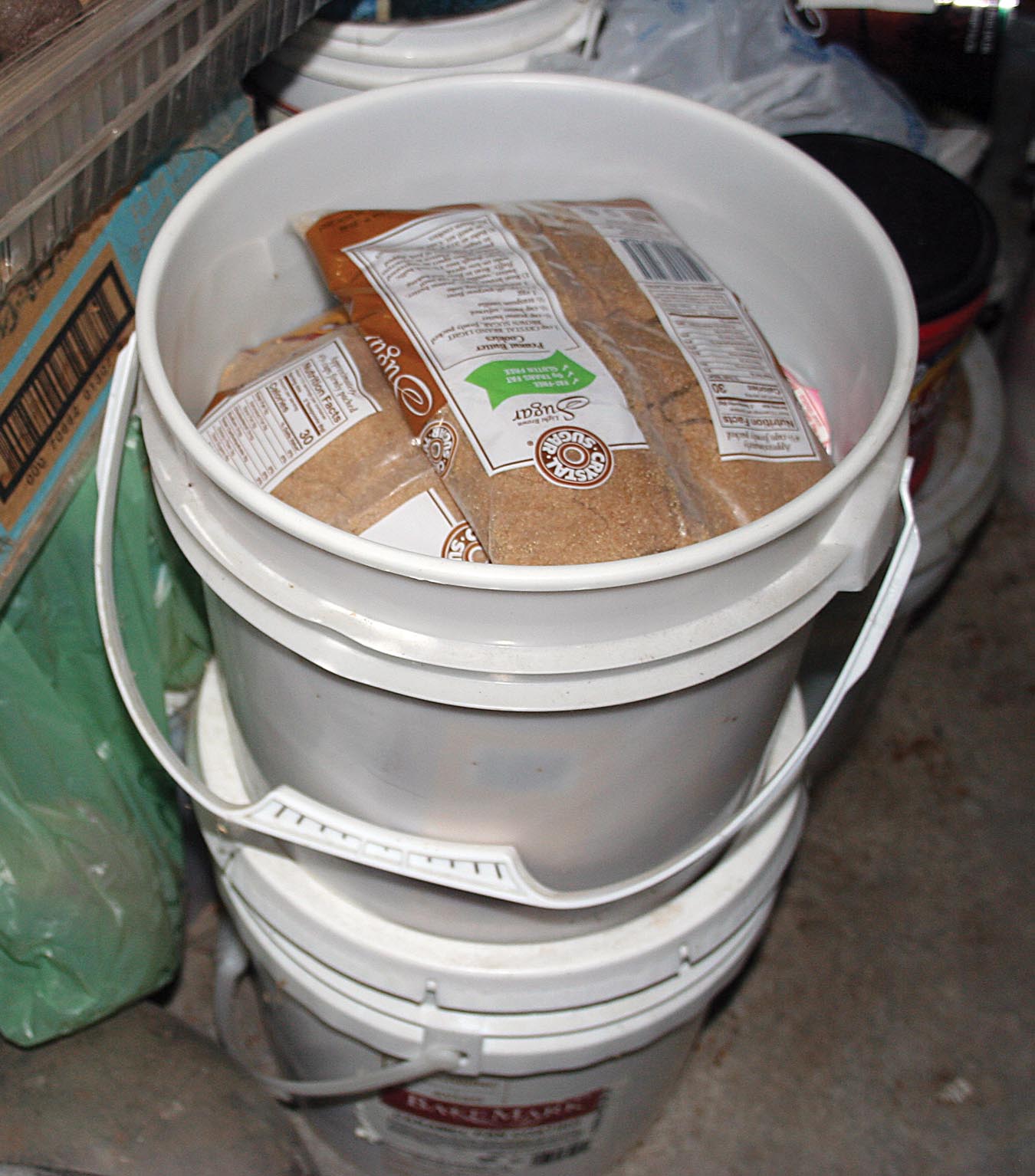
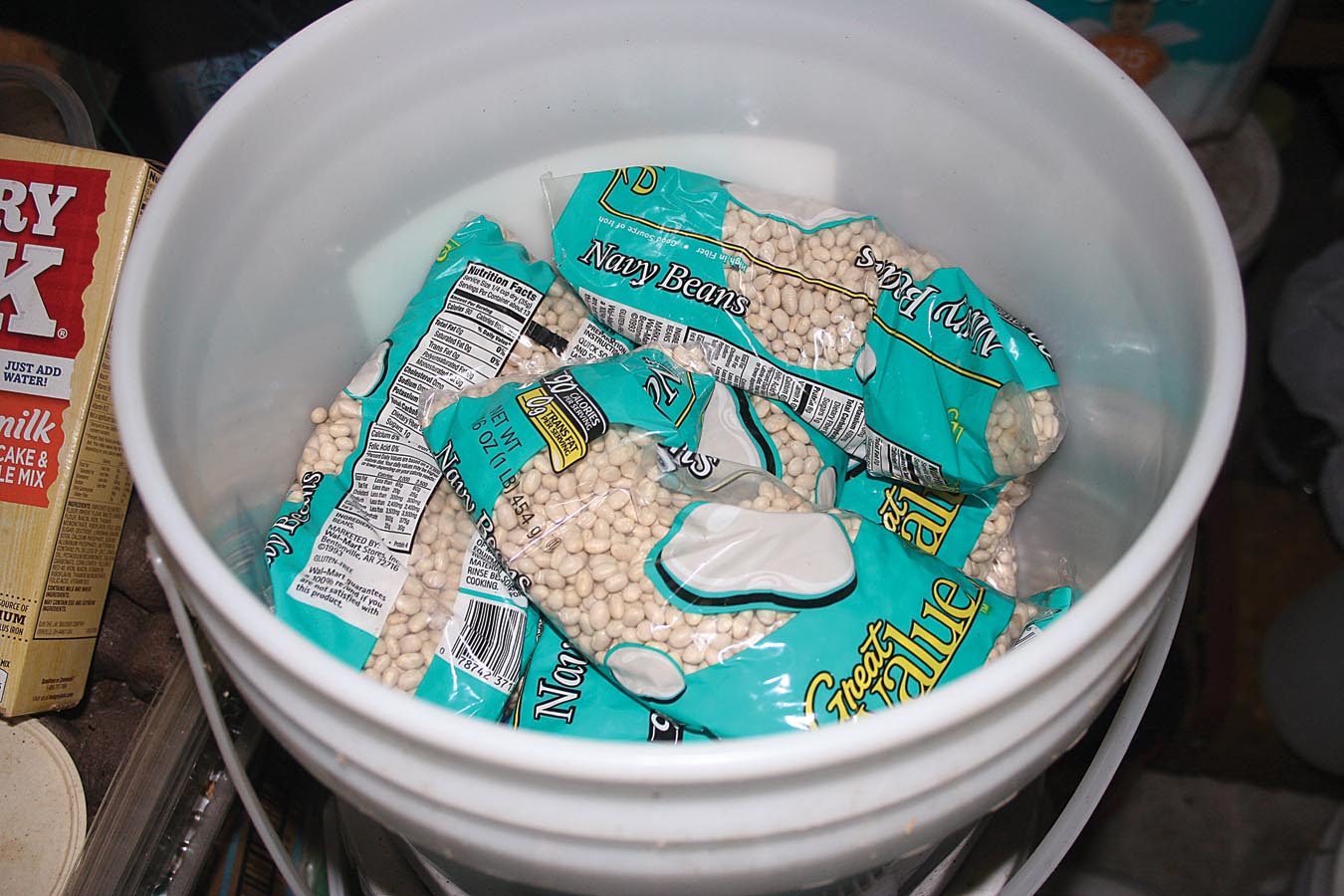
I use gasketed plastic five-gallon pails for various bags of foods.
What to put in and how to stock containers
My five-gallon buckets are filled with one variety of food only. For instance, one pail holds brown sugar, another confectioners’ sugar, and yet another homestyle noodles. I buy a little at a time until the pail is full, then I label the bucket with a permanent marker. These foods are stored in the pails in their original bags, usually plastic bags, which do a lot to protect them from possible moisture and keeping them fresher tasting.
The large garbage cans are also filled with bags of flour, store-bought cornmeal, white rice, rolled oats, etc. I also have a can of whole wheat grains and whole corn for grinding. One tip; if you don’t grow your own corn, buy a big bag or two of popcorn at Sam’s Club or Costco. Popcorn is not only a yummy snack, especially during hard times but it grinds well into tasty cornmeal. And if you grow your own sweet corn and later in the season the grains get tough due to maturity, don’t feed the cobs to the livestock. Let it dry on the stalk and then harvest the dry ears, shuck them and shell the corn to store up. Sweet corn also makes very tasty cornmeal! It is a good idea, when you grow your own grain or corn, to put the bags of grain in the freezer for a week or so to kill any weevil eggs in the grain so they don’t later hatch and ruin your food.
Do make sure you have a way to grind this whole grain into meal or flour. I have both a hand-powered Victorio grain mill and an electric Nutri-Mill (which I use most often now). Both work very well to grind grains. Some electric blenders will grind grains but do make sure yours does work before you have to count on it. Then if the power goes out, you might want to opt for a hand powered mill.
Some foods I store in large, plastic totes as they are roomy, stout, and convenient to work with. I like to store 10# bags of sugar in these totes as well as stackable bags of various foods. This brings me to another topic. What size bags of dry foods are best to buy? While many foods like flour and sugar come in 25# or even 50# bags, sometimes I prefer to buy smaller bags. Not only are they easier for my arthritic hands to work with, but sometimes they are even cheaper per pound than big bags! I was shocked to discover this as I’d always figured big bags were the best buy. Not always; be sure to check. And the smaller bags often go on sale where the larger ones don’t. Another plus especially with sugar is the 25# bags of sugar sometimes harden in long term storage. While you can always chop a chunk away then beat it into submission with a rolling pin until it regains its former texture, it’s nicer not to have to do this. I switched to storing 10# bags, left in their bags, inside a plastic tote and have never had a bag get hard yet. If you live in a very humid climate, it’s best to store sugar in completely airtight containers such as gasketed plastic pails or gallon jars.
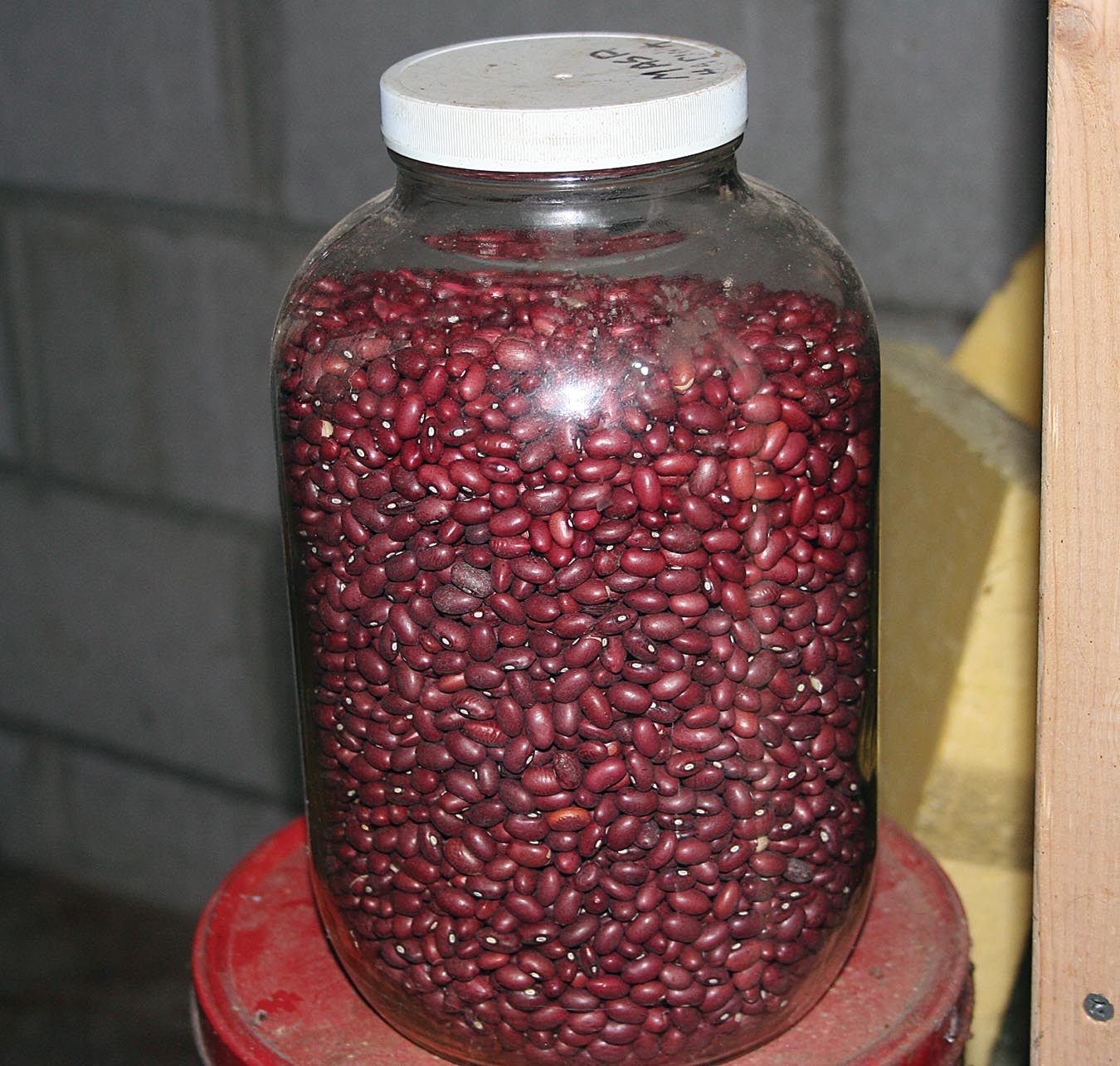
Glass or plastic gallon jars work well to store many dry foods such as these beans.
How about my dehydrated foods?
I dehydrate a whole lot of home-raised foods such as broccoli, cabbage, tomatoes, onions, peas, carrots, peppers, garlic, apples, plums, and blueberries. Like my dry staples, I store these foods in any clean, air-tight container available. I often use glass jars which canning lids and rings will not fit on, including gallon juice, vinegar, and other jars so as to conveniently recycle them at home. I usually store foods that I dehydrate a lot of like apples and cabbage in my good old popcorn tins. They hold a lot of food.
Beware of vermin!
Just like you, those little four-footed critters stockpile food and will literally eat you out of house and home. In the past, I’ve lost dry, stored food to mice, voles, squirrels, and chipmunks. The squirrels and chipmunks entered our enclosed porch through a chewed small hole in the wall next to a window where I had stored some food “temporarily.” Of course, I didn’t notice it for quite a while. But when I went to get some dehydrated plums, I was horrified to see an empty plastic jar with a hole chewed in the back side only containing rodent droppings. Dang! Likewise, mice and voles will sometimes chew holes in lighter-weight plastic containers like bags to get at the contents.
And no, you don’t have to have a rodent infested old shack to have mice! They can get in the smallest crack and hole. If you protect your storage foods by keeping them in tough containers like metal, glass, and heavy plastic they should be safe from everything but determined squirrels, which I sincerely hope you don’t have!
A good house cat is truly a gem! Our cat, Mittens, has “gifted” us with several dead mice each winter when they start coming into the house looking for a comfy place to winter. (One wasn’t so dead. Mittens brought it up to our bed when we were asleep to play with it. It ran over Will’s arm and he swatted it away. Needless to say, we didn’t get back to sleep right away!)
In the fall and winter, I also set a trap line in my pantry for the little buggers. Usually I catch a few, then that’s it. I use the good old Victor traps baited with peanut butter. And we also go over the house looking for any little cracks or holes and calk them up. It’s amazing the tiny cracks they can squeeze through, like the space around our sump pump outlet pipe. We spotted mouse tracks outside leading right up to the pipe and the crack where it went through the sill plate of the house.
Variety, variety, variety
All too often, someone will tell me they are all ready for a new lock-down or other emergency. They have a 50-pound sack of beans and 20 pounds of rice. I just say “Good luck with that!” We lived way up in the remote mountains in Montana and were snowed in for six months. Our only way to “civilization” was a snowmobile over some steep and dangerous drifts. So we had to stock up in the fall and eat what we had in the pantry. There were no McDonalds, store-bought bakery items, or fresh meat.
We learned very quickly that eating the same meals every day soon got so boring! You can bet the next year we really stocked up with a wide variety of foods, especially those I could use to bake and cook a lot of different recipes.
Here are some foods we feel are absolutely necessary to stockpile: unbleached flour, sugar, store-bought cornmeal, white rice, beans of several varieties (navy, kidney, pinto, or better yet, home-raised heirloom beans for super flavor), rolled oats, dry milk, dry buttermilk, coffee, tea, cocoa, dehydrated eggs, brown and confectioners’ sugar, soup peas, baking powder, yeast, baking soda, salt, dry pasta of various types (spaghetti, shells, wide, and narrow noodles, etc.), shortening, cooking oil, dehydrated margarine, vinegar, peanut butter, vanilla, and herbs. I also like a good supply of dehydrated fruits such as raisins, dates, apples, plums, candied fruit peel, and cranberries.
Herbs and spices
I would absolutely hate to make meals without any herbs and spices. Just salt and pepper would be very boring. I know true chefs say throw away any herbs and spices that are over a year old. I say phooey! Okay, I’ll admit, old herbs and spices may lose some of their flavor. But I have never seen that to be a problem with typical household use. I do buy spices I use frequently such as black pepper, chili powder, and cinnamon in large containers. And I keep larger containers of our home-grown herbs and spices like sage, oregano, and basil in quart canning jars in the pantry. I say forget the chefs and stock up on your favorite herbs and spices. Just leave the spices in their original containers right on your kitchen pantry shelves. If push comes to shove, you’ll be glad you have them!
You might like to check out my book, Jackie Clay’s Pantry Cookbook for a lot more information on stocking your pantry and then cooking simple, tasty recipes from that pantry. So think about what your family likes, stock up, and enjoy your good homemade cooking.
Keeping your dry foods safe from insects
Something as innocent-looking as a small white moth, fluttering across the room may signal a serious problem in your pantry. For those little moths are the adult pantry moths which lay their eggs in grains, dry cereal, and many forms of flours and meals. Folks have tried about everything to get rid of the weevils that hatch from these moths’ eggs from vinegar to Raid and other toxic insecticides. I’ll tell you, nothing works as well as not letting them get started to begin with.
As we grind flours at home from whole grains such as wheat, rye, and corn, we always freeze our shelled, winnowed grain for at least a week as this kills any nearly-microscopic eggs present. Then we store our grains and flours in insect-proof containers.
But sometimes, you’ll suddenly discover these pests in a box of corn flakes, flour, or cornmeal. There is often fine webbing present on the inside of the container and you may see either “worms” like mealworms in the food or maybe adult moths. This calls for drastic measures. First, inspect and dump out, any containers with signs of pantry moth infestation. Then immediately tie the bag shut and remove it from the house. (I dump them in the chicken yard and they love the extra treat!) Then take everything out of the cupboards and inspect them carefully. Airtight containers should have no infestation but bags and boxes should be examined for minute holes from which fine “flour” often sifts. If you open such a container, dump the contents through a sieve. Then if you don’t see any evidence, put the food in the freezer for a week … just to be sure.
Vacuum out your cupboards, taking special care to get corners. Then wash well with very hot soapy water and dry. Wipe all unopened containers well then replace in the cupboards. (I put opened boxes of dry cereal or grains in an airtight container such as a gallon glass jar to protect them. If air can’t get in, neither can pantry moths!)
I have a lot of faith in using pantry moth traps in my house. These sticky traps are baited with pheromones, which attract male moths and drastically reduce the population quickly.
Again, the best way to keep pantry moths from destroying your food is to prevent them from getting at it in the first place. Remember, they love lots of common pantry food: bird sunflower seeds, dry breakfast cereal, pancake mixes, cornmeal, flour, whole grains, and even dry dog food. Keep an eye out so you get to eat the food you store!
Storing vegetables
Our pantry is stuffed with home canned foods and buckets, bins, and cans full of various dry foods. We also grow several huge gardens and store a lot of our produce for over-winter use as well.
Where most folks figure all vegetables should be stored in a cold root cellar, some should not. For instance, pumpkins, squash, onions, and garlic store much better in normal household temperatures. I used to store everything in cold storage, but then I discovered a two-year-old Hopi Pale Grey squash under my bed. Ah ha! I figured if that squash liked warmer temperatures, maybe others did too. Now, years later, I store these crops in the spare bedroom, heated back porch, and even living room! And most keep until spring easily. However, it is good to note that not all varieties store equally well. For instance, Walla Walla sweet onions and Acorn squash will only store for a few weeks before going bad. So, pay attention to the storage ability of the crops you intend to store.
Never try to store pumpkins or squash which have been frosted, frozen, or have their stems broken off. They will quickly rot.
Most root crops do store best in cool temperatures. These include potatoes, carrots, turnips, and rutabagas. I store my potatoes, turnips, and rutabagas in individual (per type of crop) covered plastic totes in our unheated basement where the temperature in the winter is usually 40-50° F, sometimes dipping down into the high 30s.
Here, our stored vegetables will usually stay very usable until late spring or even longer.
Potatoes are best stored unwashed but with the dirt brushed off after they lay out in the garden soil on a sunny day or two to cure the skins. I put them in bins which are covered to prevent any light from shining on them (even a light bulb occasionally). Light will turn your potatoes green. This is not only unappetizing but actually toxic.
I open my bins from time to time, not only to use the potatoes or other vegetables, but also to make sure they are not getting too humid, as evidenced by water droplets appearing on the lids of the bins. If this is not addressed, the crop will mold and rot. If I see these droplets, I just leave the top of the bin unsnapped and lightly in place for a few days, then replace it tightly.
If you have turnips or rutabagas that begin to soften, just can them up to save them. They are very good that way!
It’s often said that you shouldn’t store potatoes and apples in the same area as the apples give off ethylene gas which is thought to not only keep potatoes from sprouting but can cause premature rotting. While I wouldn’t store them in the same container, I do store bins of apples on the opposite side of my 7-foot wide basement pantry in open bins.
Store your apples in a cool basement, garage, shed, or root cellar. The ideal storage temperature is 30-32° F with 90 percent humidity. Apples are likely to suffer freeze damage if the temperature dips below 30 degrees. However, my apples do keep quite well in my 40-degree unheated basement set in bins on the cold floor which I’m sure is cooler than 40 degrees.
Never store bruised or damaged root crops as they will not only quickly spoil but also spoil those in contact with them.
There are two efficient ways to store carrots. My gardening and homesteading friend Dara cuts the tops off the carrots, washes them in the sink, then dries them in the dish drainer until pretty dry. Then they are packed into gallon-sized plastic bags with a few small slits cut in the sides, then enclosed with a zipper closure. She stores these bags in the refrigerator or in her cold root cellar. They stay good until spring easily. I use medium sized plastic bins. I cut the tops off the carrots, then stack them standing upright in the bins and pour clean, moist sand over them continuing until the bin is full. I put the top on the bin loosely so the carrots can breathe but there isn’t light available. Mine stay good until spring also.
There are many crops which have limited cool storage. The most commonly stored vegetable, other than the above-mentioned, is cabbage. I routinely store heads of cabbage, first outside on our unheated, open front porch until the temps dive into the below freezing mark, then I bring them in and hang upside-down, by the roots, from nails in the basement floor joists. Pulled cabbages will last much longer than will those which have been cut.
Tomatoes and peppers too will last quite a while if you pull the entire plant and hang them upside down by their roots. I’ve had fresh tomatoes and peppers for Christmas by doing this method, which is common in countries such as Italy and Mexico.
As I’ve said before, do make sure any foods from your garden you intend to store are varieties with long-term storage capability. For instance, our Norland apples will only keep for a week or two, no matter where we store them. Another, Honeycrisp, will keep all winter happily. In fact, long storage usually improves the sweetness. When food storage is your plan, choose your varieties carefully and you’ll eat well all winter! D


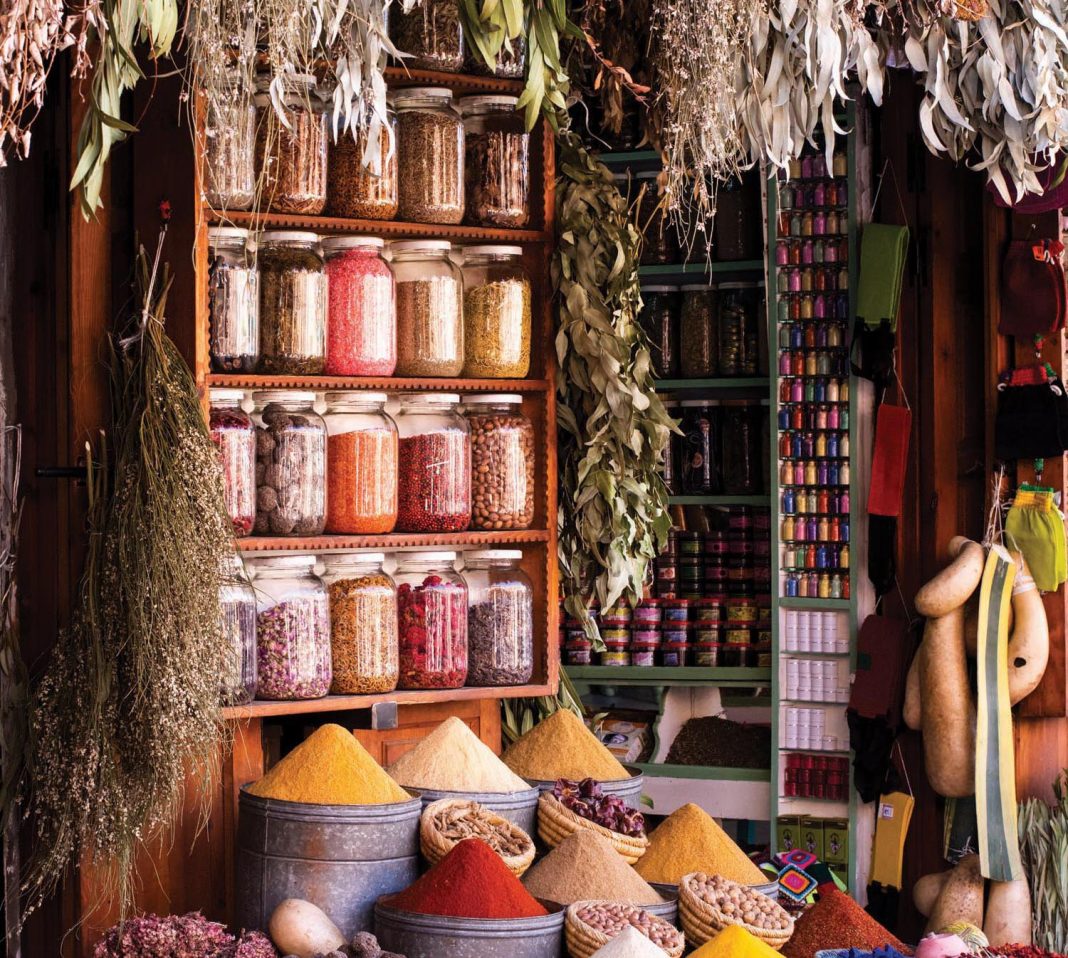










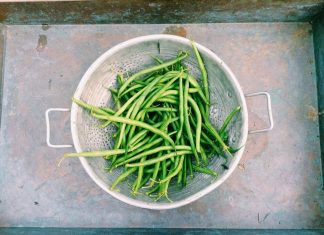

Love this article! I am pleased to see that I am doing my food storage correctly. My Dad has picked up many empty glass gallon pickle jars that a local sandwich shop puts out for trash. I scrub them well and use them for much of my dry storage. Cheap and safe from critters. I love your blog and articles, keep’em coming please!